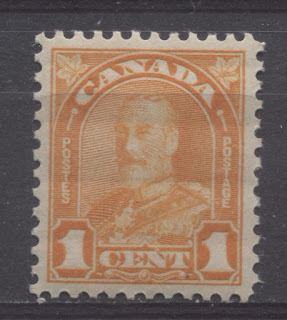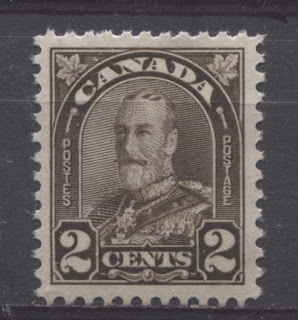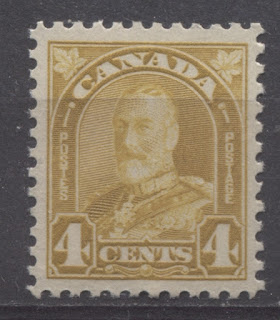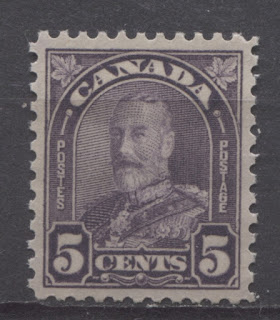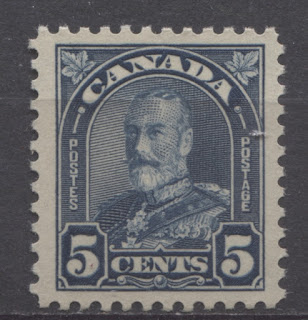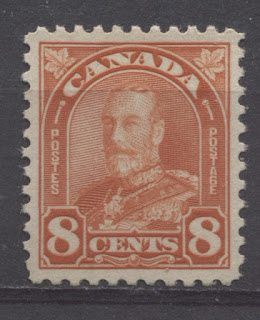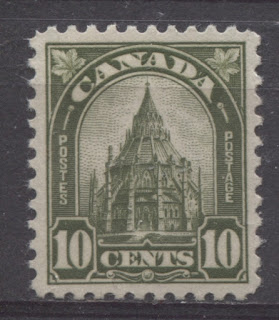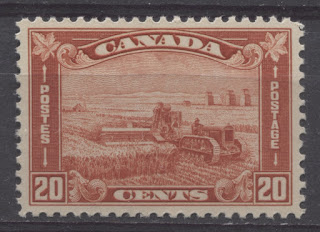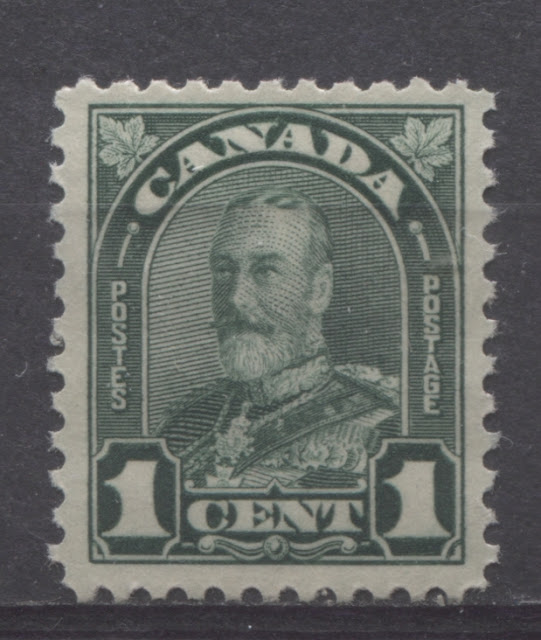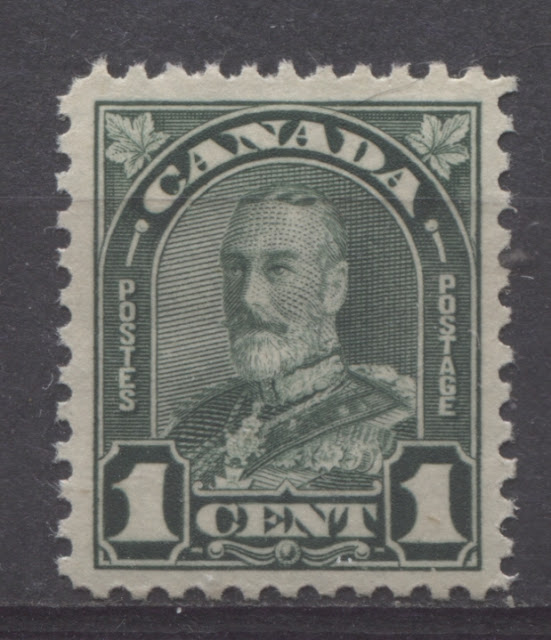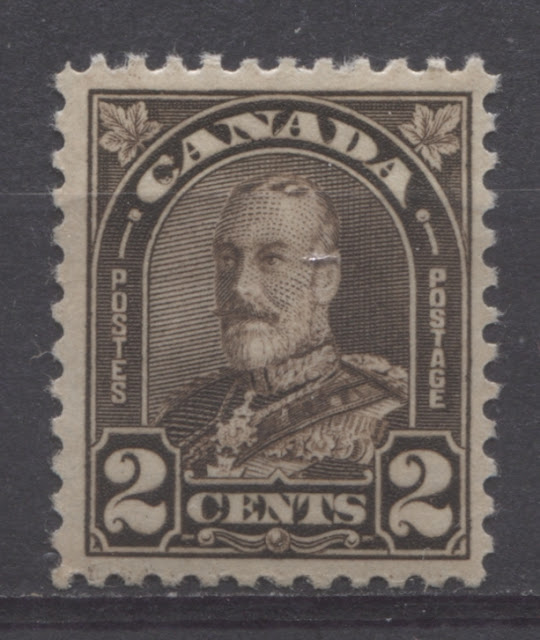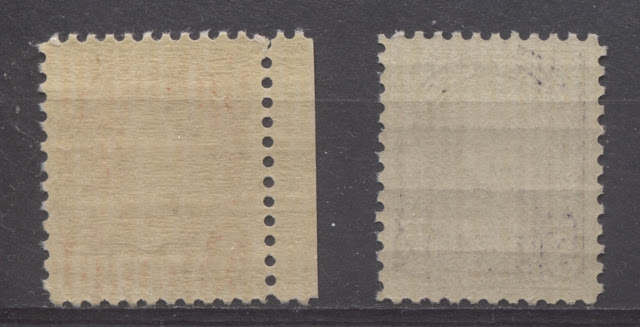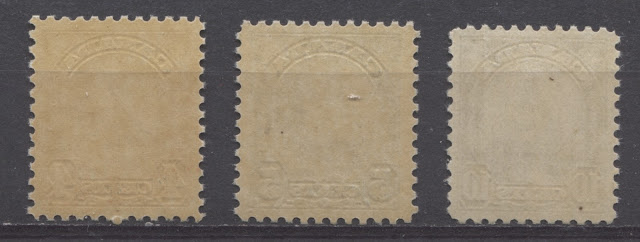Overview
This issue was the first to be printed by the British American Bank Company, when they took the contract for printing stamps from the Canadian Bank Note Company in 1930. They held the contract for five years until 1935, when the Canadian Bank Note Company got it back. For those looking for superbly centered stamps, this period will represent a very worthy challenge because superb centering is very difficult to find and because most stamps from this period were perforated 11 and not 12, it is hard to find stamps with even perforations on all four sides. In addition, this was the first issue to be printed using more than one printing process: The low values from the 1c to the 3c, and some printings of the 5c violet were all printed using the Stickney rotary presses, while the other values were all printed on flat plates. In addition, several of the booklet panes of the 1c and 2c values were printed from flat plates as well.
It is also the only issue to feature both die types and colour changes in all values to the 8c, except the 3c and 4c. As we will see, the values up to the 8c were all replaced by the Medallion issue by December 1932. However, the higher values being the 20c, 50c and $1 were not replaced until the Dated Die Issue appeared on June 1, 1935. The 10c was replaced by a different design bearing a portrait of Sir Georges Etienne Cartier and used until June 1, 1935. This will be dealt with in a separate post dealing with the 1931 provisional surcharges. This series of two posts will concentrate on the regular issue postage stamps, the airmail issue and special delivery issues. Herman Herbert Schwartz was the designer of the set, while the King George V portrait was engraved by Carl Theodore Arlt. All values to the 10c were printed in sheets of 100, while the high values were printed in sheets of 200 that were guillotined into four panes of 50. Plate 3 of the 8c red-orange was printed in sheets of 400 that were then guillotined into four panes of 100.
This period is also, in my opinion, the most neglected in all of early modern Canadian philately. Unitrade does list a few shade varieties, and a few plate flaws, but careful study of the stamps issued during this five year period will reveal that there were many shade varieties as well as highly discernible paper and gum variations. Finally, due to the colour changes, some of the stamps in this set like the 1c orange, 5c violet and 8c dark blue have very short periods of use, making them excellent candidates for in-period postmark collections.
This is a fantastic series for the specialist, due to its large number of plates, the shades, paper and gum varieties, as well as the large number of coils, booklets and postal stationery items.
The Stamp Designs and Quantities Issued



2c Scarlet Vermilion or 2c Agate Die 1
Flat Plate Gum
The stamps above illustrate the tremendous variation that can be found in the gum of the flat plate printings. The significance of these differences is that the various gum types can actually be used to assign individual stamps to different printings as follows:
This issue was the first to be printed by the British American Bank Company, when they took the contract for printing stamps from the Canadian Bank Note Company in 1930. They held the contract for five years until 1935, when the Canadian Bank Note Company got it back. For those looking for superbly centered stamps, this period will represent a very worthy challenge because superb centering is very difficult to find and because most stamps from this period were perforated 11 and not 12, it is hard to find stamps with even perforations on all four sides. In addition, this was the first issue to be printed using more than one printing process: The low values from the 1c to the 3c, and some printings of the 5c violet were all printed using the Stickney rotary presses, while the other values were all printed on flat plates. In addition, several of the booklet panes of the 1c and 2c values were printed from flat plates as well.
It is also the only issue to feature both die types and colour changes in all values to the 8c, except the 3c and 4c. As we will see, the values up to the 8c were all replaced by the Medallion issue by December 1932. However, the higher values being the 20c, 50c and $1 were not replaced until the Dated Die Issue appeared on June 1, 1935. The 10c was replaced by a different design bearing a portrait of Sir Georges Etienne Cartier and used until June 1, 1935. This will be dealt with in a separate post dealing with the 1931 provisional surcharges. This series of two posts will concentrate on the regular issue postage stamps, the airmail issue and special delivery issues. Herman Herbert Schwartz was the designer of the set, while the King George V portrait was engraved by Carl Theodore Arlt. All values to the 10c were printed in sheets of 100, while the high values were printed in sheets of 200 that were guillotined into four panes of 50. Plate 3 of the 8c red-orange was printed in sheets of 400 that were then guillotined into four panes of 100.
This period is also, in my opinion, the most neglected in all of early modern Canadian philately. Unitrade does list a few shade varieties, and a few plate flaws, but careful study of the stamps issued during this five year period will reveal that there were many shade varieties as well as highly discernible paper and gum variations. Finally, due to the colour changes, some of the stamps in this set like the 1c orange, 5c violet and 8c dark blue have very short periods of use, making them excellent candidates for in-period postmark collections.
This is a fantastic series for the specialist, due to its large number of plates, the shades, paper and gum varieties, as well as the large number of coils, booklets and postal stationery items.
The Stamp Designs and Quantities Issued
1c Orange King George V.
Issued July 17, 1930.
Replaced December 6, 1930.
74,900,000 sheet stamps.
2,000,000 coil stamps.
4,350,000 pre-cancelled coil stamps.
1c Myrtle green - King George V.
Issued December 6, 1930.
Replaced December 1, 1932.
423,000,000 sheet stamps in 2 die types.
2,038,000 booklet stamps in 2 formats.
16,427,000 coil stamps.
11,130,000 pre-cancelled coil stamps.
2c Dull yellowish green King George V.
Issued June 6, 1930.
Replaced November 17, 1930.
319,000,000 sheet stamps.
6,762,000 booklet stamps.
20,000,000 coil stamps.
2c Scarlet vermilion King George V.
Issued November 17, 1930.
Replaced July 1, 1931.
431,000,000 sheet stamps in 2 die types.
10,854,000 booklet stamps.
24,880,000 coil stamps.
2c Agate King George V.
Issued July 4, 1931.
Replaced December 1, 1932.
356,000,000 sheet stamps in 2 die types.
2,350,000 booklet stamps in 2 formats.
25,255,000 coil stamps.
3c Deep scarlet King George V.
Issued July 13, 1931.
Replaced December 1, 1932.
492,000,000 sheet stamps.
16,064,000 booklet stamps.
37,190.000 coil stamps.
4c Yellow bistre King George V.
Issued November 5, 1930.
Replaced December 1, 1932.
11,100,000 stamps.
5c Deep reddish lilac King George V.
Issued June 18, 1930.
Replaced November 13, 1930.
10,300,000 stamps printed using both processes.
5c Deep dull blue King George V.
Issued November 13, 1930.
Replaced December 1, 1932.
45,500,000 stamps.
8c Dark blue King George V.
Issued August 13, 1930.
Replaced November 5, 1930.
888,000 stamps.
8c Deep red-orange King George V.
Issued November 5, 1930.
Replaced December 1, 1932.
5,912,000 stamps.
10c Olive green Library of Parliament.
Issued September 15, 1930.
Replaced September 30, 1931.
21,100,000 stamps.
12c Grey-black Old Quebec Citadel
Issued December 4, 1930.
Replaced December 1, 1932 by 13c.
6,975,000 stamps.
20c Brown-red Harvesting Wheat.
Issued December 4, 1930.
Replaced June 1, 1935.
21,000,000 stamps.
50c Prussian blue Grand Pre.
Issued December 4, 1930.
Replaced June 1, 1935.
2,811,000 stamps.
$1 Deep olive - Mt. Edith Cavell
Issued December 4, 1930.
Replaced June 1, 1935.
606,000 stamps.
5c Deep brown Mercury & Globe.
Issued December 4, 1930.
Replaced February 22, 1932.
400,000 stamps
20c Henna brown Special Delivery
Issued September 2, 1930.
Replaced December 24, 1932.
950,000 stamps.
Points of Interest
There are many, many points of interest for the specialist of this issue:
- Die type differences
- Paper and gum differences
- Shades
- Re-entries
- Plate flaws
- Plate blocks
- Booklets and booklet panes
- Potential design size differences
- Postal History and cancellations
- First day covers
- Coil stamps
- Imperforate pairs
- Proof material
In this post, I will cover the first three of these, and then my next post will cover the rest.
Die Types on the 1c and 2c
1c Myrtle Green Die 2
The above stamp is from die 2, which has the following characteristics:
- The curved lines inside the ball ornaments that flank the word "Canada" are long, and cover half the circumference of the ball.
- There are four horizontal lines between the top of the "P" of "Postage" and the bottom stem of the above ornaments.
1c Myrtle Green Die 1
On die 1, the following characteristics can be seen:
- The curved lines inside the ball ornaments that flank the word "Canada" are short, and cover less than half the circumference of the ball.
- There are only three horizontal lines between the top of the "P" of "Postage" and the bottom stem of the above ornaments.
One reader has informed me that on the Colnect website, he has found a notation to the effect that both these die types can be found on the 1c orange. I am not disputing this, but I am not aware of this value existing with any die type, except for die 1.
2c Scarlet Vermilion or 2c Agate Die 2On die 2 for this value:
- The curved lines inside the ball ornaments that flank the word "Canada" are long, and cover half the circumference of the ball.
- The "P" of "Postage" almost resembles a "D" because the dot of colour in the centre is so large.
2c Scarlet Vermilion or 2c Agate Die 1
On Die 1 for this value:
- The curved lines inside the ball ornaments that flank the word "Canada" are short, and cover less than half the circumference of the ball.
- The "P" of "Postage" encloses a small dot of colour, so that it still looks like a "P".
These are the two sets of known die type differences that are documented in the philatelic literature. Of course, the possibility always exists that there may be differences on other values, or additional types that have just not been discovered yet on these values. However, it is not likely that more will be found.
Paper and Gum Differences
The paper of this issue can be found either showing no mesh at all, or showing a fine vertical mesh. Generally, the paper on the rotary press printings is thick and opaque showing no mesh. Where we see really significant differences between printings is in the appearance and colour of the gum. The gum on rotary press printings and on flat plate printings is very distinct.
Rotary Press Gum
As you can see above, there is variation in both the colour of the gum on rotary press printings, as well as the visibility of the dark vertical streaks in the gum, with the streaks being much more visible on the stamp with white gum at right, than the stamp with cream gum at left. The horizontal lines visible in the scans are light ridges called Gum Breaker Ridges and are placed on the stamps to prevent curling. The gum colours above are light cream and white, through occasionally it is possible to find gum that is even whiter than the stamp on the right.Flat Plate Gum
The stamps above illustrate the tremendous variation that can be found in the gum of the flat plate printings. The significance of these differences is that the various gum types can actually be used to assign individual stamps to different printings as follows:
- Light cream gum (top right stamp) is generally found on the 1930 issues.
- Cream gum (top centre stamp) is generally found on either the 1931 issues.
- Deep cream gum (top left stamp) is also generally from the 1931-32 period.
- Mottled deep coffee gum (bottom row) is from the 1932-1933 period.
Coffee gum refers to a colour that is a distinct brownish cream.
Shade and Gum Combinations
The only shades listed in Unitrade are the 5c milky blue shade, and the pale blue shade of the 50c. In reality there are many more collectible shades than this. The following are the shade and gum combinations that I have seen while handling stocks of mint stamps of this issue:
- 1c reddish orange with cream gum and visible streaks.
- 1c orange with cream gum and visible streaks.
- 1c orange with white gum and indistinct streaks.
- 1c orange with cream gum and indistinct streaks.
- 1c deep orange with cream gum and distinct streaks.
- 1c pale yellow orange coil with cream gum and distinct horizontal streaks.
- 1c light yellow orange coil with cream gum and distinct horizontal streaks.
- 1c yellow orange coil with deep cream gum and distinct horizontal streaks.
- 1c yellow orange coil with cream gum and distinct horizontal streaks.
- 1c orange coil with deep cream gum and distinct horizontal streaks.
- 1c orange coil with cream gum and distinct horizontal streaks.
- 1c pale bright orange coil with cream gum and distinct horizontal streaks.
- 1c pale bright orange coil with cream gum and indistinct horizontal streaks.
- 1c bright orange coil with cream gum and indistinct horizontal streaks.
- 1c myrtle green, die 2 with cream gum and distinct streaks.
- 1c myrtle green, die 2 with cream gum and indistinct streaks.
- 1c deep dull green, die 2 with cream gum and indistinct streaks.
- 1c deep green, die 2 with cream gum and indistinct streaks.
- 1c deep green, die 1 with cream gum and distinct streaks.
- 1c deep dull green, die 1 with cream gum and indistinct streaks.
- 1c myrtle green, die 1 with cream gum and indistinct streaks.
- 1c myrtle green, die 1 with cream gum and distinct streaks.
- 1c myrtle green coil with cream gum and distinct horizontal streaks.
- 1c myrtle green coil with cream gum and distinct horizontal streaks.
- 1c bottle green coil with white gum and indistinct horizontal streaks.
- 1c bottle green coil with cream gum and indistinct horizontal streaks.
- 1c deep dull green coil with cream gum and no streaks.
- 2c deep dull green with cream gum and indistinct streaks.
- 2c deep yellowish green with white gum and indistinct streaks.
- 2c deep yellowish green with cream gum and indistinct streaks.
- 2c deep green with cream gum and indistinct streaks.
- 2c yellowish green with cream gum and distinct streaks.
- 2c deep green flat plate booklet with deep cream gum and clear vertical mesh.
- 2c deep yellowish green rotary booklet with cream gum and distinct streaks.
- 2c deep green coil with cream gum and distinct horizontal streaks.
- 2c deep green coil with white bubbly gum.
- 2c deep green coil with cream gum and indistinct horizontal streaks.
- 2c deep dull green coil with cream gum and no streaks.
- 2c deep dull green coil with cream gum and distinct horizontal streaks.
- 2c scarlet vermilion, die 1 with cream gum and indistinct streaks.
- 2c scarlet vermilion, die 1 with cream gum and distinct streaks.
- 2c dull scarlet vermilion, die 1 with cream gum and distinct streaks.
- 2c scarlet, die 1 with cream gum and indistinct vertical streaks.
- 2c pale scarlet vermilion, die 1 with cream gum and indistinct vertical streaks.
- 2c bright scarlet, die 2 with cream gum and indistinct vertical streaks.
- 2c scarlet, die 2 with cream gum and indistinct vertical streaks.
- 2c scarlet flat plate booklet with deep yellowish cream gum and clear vertical mesh.
- 2c scarlet vermilion coil with cream gum and indistinct horizontal streaks.
- 2c scarlet vermilion coil with cream gum and distinct horizontal streaks.
- 2c deep scarlet coil with cream gum and distinct horizontal streaks.
- 2c bright scarlet coil with cream gum and no distinct streaks.
- 2c blackish brown, die 2 with cream gum and distinct streaks.
- 2c blackish brow, die 2 with cream gum and indistinct streaks.
- 2c blackish brown, die 2 with white gum and indistinct streaks.
- 2c deep sepia, die 2 with cream gum and distinct streaks.
- 2c deep sepia, die 2 with cream gum and indistinct streaks.
- 2c agate, die 1 with cream gum and indistinct streaks.
- 2c agate, die1 with white gum and indistinct streaks.
- 2c deep sepia, die 1 with white gum and indistinct streaks.
- 2c blackish brown coil with cream gum and indistinct horizontal streaks
- 2c agate coil with cream gum and distinct horizontal streaks.
- 2c agate coil with cream gum and indistinct horizontal streaks.
- 3c bright scarlet with cream gum and indistinct streaks.
- 3c bright scarlet with cream gum and distinct streaks.
- 3c scarlet with cream gum and distinct streaks.
- 3c scarlet with cream gum and indistinct streaks.
- 3c rose scarlet with cream gum and indistinct streaks.
- 3c scarlet vermilion with cream gum and distinct streaks.
- 3c bright scarlet flat plate booklet with yellowish cream gum and clear vertical mesh.
- 3c scarlet vermilion flat plate booklet with yellowish cream gum and clear vertical mesh.
- 3c scarlet coil with cream gum and indistinct horizontal streaks.
- 3c scarlet coil with cream gum and distinct horizontal streaks.
- 3c scarlet vermilion coil with cream gum and indistinct streaks.
- 3c deep bright scarlet coil with cream gum and no streaks.
- 3c deep bright rose red coil with cream gum and indistinct horizontal streaks.
- 3c deep rose-red coil with cream gum and distinct horizontal streaks.
- 4c yellow bistre with deep cream gum.
- 4c yellow bistre with deep coffee gum.
- 4c deep bistre yellow with deep cream gum.
- 4c deep yellow bistre with deep coffee gum.
- 4c pale yellow bistre with coffee gum.
- 4c pale yellow bistre with deep cream gum.
- 4c pale yellow bistre with cream gum.
- 4c deep golden yellow with deep cream gum.
- 4c deep yellow with deep coffee gum.
- 4c deep yellow with deep cream gum.
- 5c dull plum, rotary with white gum and distinct streaks.
- 5c dull plum, rotary with white gum and indistinct streaks.
- 5c deep dull purple, rotary with cream gum and distinct streaks.
- 5c deep dull purple, rotary with cream gum and indistinct streaks.
- 5c deep rose-lilac, rotary with cream gum and distinct streaks.
- 5c deep rose-lilac, rotary with white gum and distinct streaks.
- 5c deep dull greyish purple, flat press with cream gum.
- 5c deep dull greyish purple, flat press with deep cream gum.
- 5c deep dull greyish purple, flat press with deep coffee gum.
- 5c Prussian blue with deep cream gum.
- 5c Prussian blue with deep coffee gum.
- 5c Prussian blue with cream gum.
- 5c steel blue with coffee gum.
- 5c steel blue with deep cream gum.
- 5c deep steel blue with deep coffee gum.
- 5c light Prussian blue with cream gum.
- 5c light Prussian blue with deep cream gum.
- 5c light steel blue with cream gum.
- 5c light steel blue with deep cream gum.
- 8c deep Prussian blue with cream gum.
- 8c deep Prussian blue with deep cream gum.
- 8c deep steel blue with cream gum.
- 8c Prussian blue with cream gum.
- 8c Indigo with white gum.
- 8c reddish orange with coffee gum.
- 8c pale bright reddish orange with deep cream gum.
- 8c deep reddish orange with mottled deep coffee gum.
- 8c dull red orange with cream gum.
- 8c deep orange red with deep cream gum.
- 8c deep orange red with coffee gum.
- 8c bright red orange with deep cream gum.
- 8c reddish orange with cream gum.
- 8c orange-red with deep coffee gum.
- 8c deep bright orange-red with deep cream gum.
- 10c olive green with light cream gum.
- 10c olive green with deep cream gum.
- 10c deep olive with deep cream gum.
- 10c deep olive with coffee gum.
- 10c bronze green with deep cream gum.
- 10c deep grey olive with deep cream gum.
- 10c deep grey olive with deep coffee gum.
- 10c deep bright olive with yellowish cream gum.
- 10c deep olive green with deep cream gum.
- 12c grey-black with deep cream gum and clear vertical mesh.
- 12c grey-black with light cream and clear vertical mesh.
- 12c grey-black with mottled coffee gum and clear vertical mesh.
- 12c grey-black with deep coffee gum.
- 12c deep grey-black with mottled coffee gum.
- 12c deep grey-black with cream gum.
- 20c deep bright Indian red with deep cream gum.
- 20c brownish vermilion with cream gum.
- 20c brownish vermilion with deep cream gum.
- 20c deep Indian red with cream gum.
- 20c deep Indian red with deep cream gum.
- 20c deep brownish vermilion with cream gum.
- 20c deep brownish vermilion with deep cream gum.
- 20c very deep bright orange vermilion with deep cream gum.
- 50c bright steel blue with mottled coffee gum.
- 50c bright steel blue with cream gum.
- 50c bright steel blue with light cream gum.
- 50c deep Prussian blue with cream gum.
- 50c Prussian blue with deep cream gum.
- 50c Prussian blue with cream gum.
- 50c Steel blue with cream gum.
- 50c pale Prussian blue with cream gum.
- $1 deep grey olive with cream gum.
- $1 deep olive with cream gum.
- $1 deep olive with deep cream gum.
- $1 bronze green with cream gum.
I am sure that this is by no means an exhaustive list. Admittedly, some of the variations listed here may be too subtle for many collectors. However, what is very clear is that there are a lot more collectible varieties to this issue than Unitrade lists. The above list also covers only the regular issues. I will deal with the 5c airmail and 20c special delivery stamp in next week's post. Finally, the significance of the distinction between how distinct the streaks in the rotary press gum are is not yet understood. However, this would be a good topic to study in order to determine what the significance is, if any.


